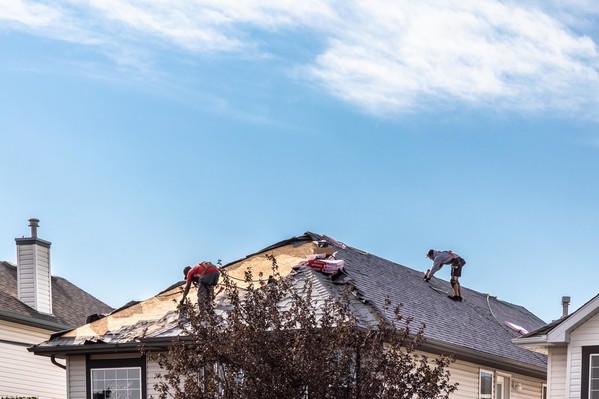Climate hazards: Hail and high wind
This page provides non-emergency solutions to tackle climate change. If you are in an emergency, visit what to do during hail or what to do during high wind.
Hail and high wind events in Calgary might be isolated events, but can produce significant, high-cost impacts. According to climate projections, we expect to see larger hailstones in the future, and it’s more likely that hailstorms will occur throughout more of the year. With a changing climate, we will also continue to experience high wind gust events.
Calgary is located in “hail alley”, the epicentre for hailstorms in Canada. Depending on the size of hailstones, the wind speed and the duration of a storm, hail can cause significant damage to your home’s roof, exterior walls, doors and windows, and outdoor structures like porches and decks. This type of damage to your home can allow water in, leading to even more damage.
Hail
Hail Vulnerability
-
Download the hail and high wind handout.
All communities within Calgary are equally exposed to hail. Consider the following questions. The more questions you answer as YES, the more vulnerable your home and property may be to hail damage.
| Question | Yes/No |
|---|---|
| Has your home previously been damaged by hail? | |
| Do you park your vehicle (if you own one) in an unprotected area at home (e.g., not in a carport or garage)? | |
| Do you have a flat or almost flat roof? | |
| Do you have skylights? | |
| Do you have aluminum or vinyl siding? | |
| Do you have an older roof with low-quality roofing material that is not impact resistant rated? | |
| Do you have older, low-quality windows that are not impact resistant rated? |
How to reduce hail impacts to your home
Some of the most impactful measures to reduce the impact to your home and property from hail include:
Do
- Learn more about how well different roofing materials and siding materials perform against hail if you are replacing your roof or siding.
- Purchase and install impact resistant windows and doors and put a safety film on your windows.
- Install protective shutters (roll shutters or storm shutters) on the outside of your windows. These will also offer protection against extreme heat events.
- Visit hail-smart.com to learn more about how to help protect your home, vehicle, and small business from hail. The Institute for Catastrophic Loss Reduction (ICLR) has a robust site with many resources.
- Consider a steeper roof if you are building new. Hip roofs are the most resilient to hail damage. The steeper the slope of your roof, the less hail will damage it.
High wind
In Calgary, the strongest winds are usually caused by severe thunderstorms, intense low-pressure centers and cold fronts, and chinooks. High wind events occur fairly frequently in Calgary and can last from minutes to hours. Tornadoes are also possible, but less likely. With a changing climate, we expect to continue to experience high wind gust events in Calgary.
High wind vulnerability
All communities within the city are equally exposed to high winds. Consider the following questions. The more questions you answer as YES, the more vulnerable your home and property may be to damage from high winds.
| Question | Yes/No |
|---|---|
| Do you have a complex roof design? | |
| Do your roofing materials (e.g., shingles) appear to be worn and/or damaged? | |
| Check your roof edge attachments. Is the edge of your roofing material (e.g., shingles) starting to peel back or is it poorly connected to the roof structure? For example, can you easily peel them back? | |
| Are your soffits, fascia and gutters old and/or showing signs of damage? | |
| Were your roofing materials installed without underlayment? | |
| Do you have a number of items stored outdoors which are not anchored down (e.g., trampoline, playground equipment, furniture, etc.)? | |
| Do you have older windows and doors which are not pressure-rated or reinforced? | |
| Do you have unmaintained or unhealthy trees? These are at higher risk of failure and could cause damage to other property. |
How to reduce high wind impacts
Some of the most impactful measures to reduce the impact to your home and property from high wind include:
Do
- Learn more about how well different roofing materials and siding materials perform against high wind if you are replacing your roof or siding.
- Purchase and install impact resistant windows and doors and put a safety film on your most exposed windows.
- Install protective shutters (roll shutters or storm shutters) on the outside of your windows.
- Securely anchor outdoor accessories and equipment, such as trampolines, furniture and playground equipment.
- Properly prune and maintain trees around your house. Proper maintenance from a certified arborist will reduce the likelihood of failure.
Learn more
For more information about staying safe before, during, and after a high wind event, visit What to do during high winds.

For more information about protecting your home and property from high wind, refer to the Institute for Catastrophic Loss Reduction’s Homeowner Guide: Protect Your Home From Severe Wind.
Translated handouts
Disclaimer: The content of the Climate Ready Home Guide is for informational purposes only and cannot be construed as technical advice with respect to any particular building(s) or construction project(s). The Climate Ready Home Guide does not recommend or endorse specific products or companies. All products and measures should be installed by a professional contractor, according to manufacturer specifications and following all City Bylaws and codes.

